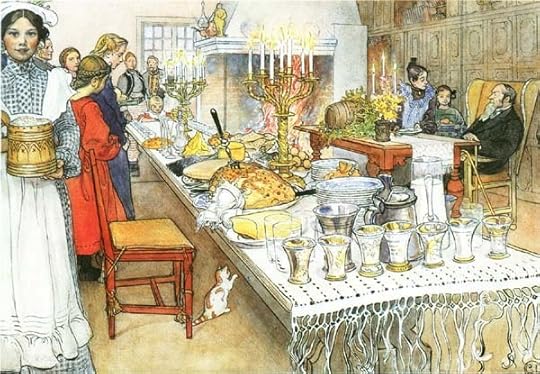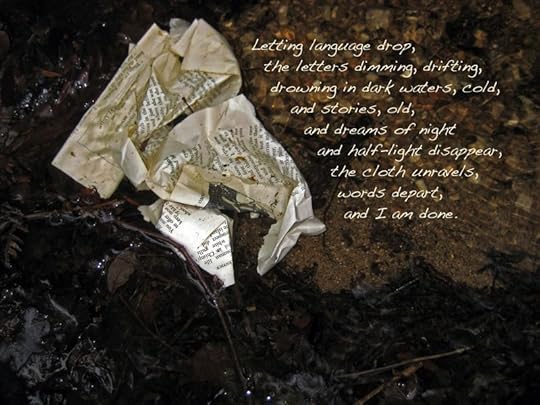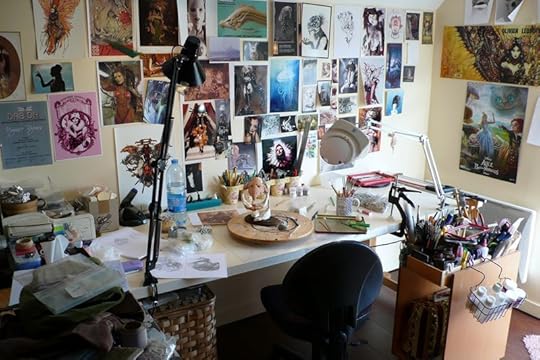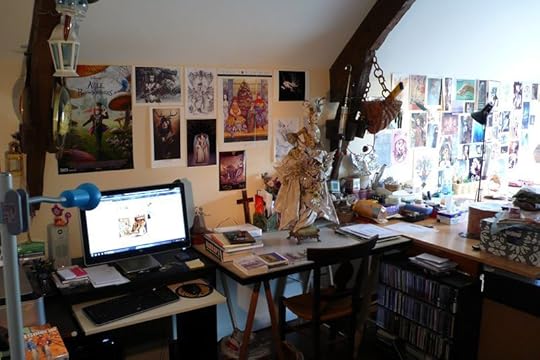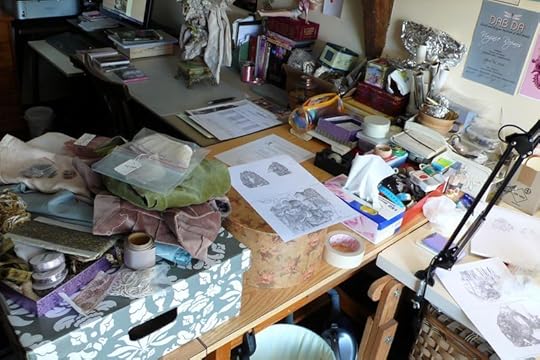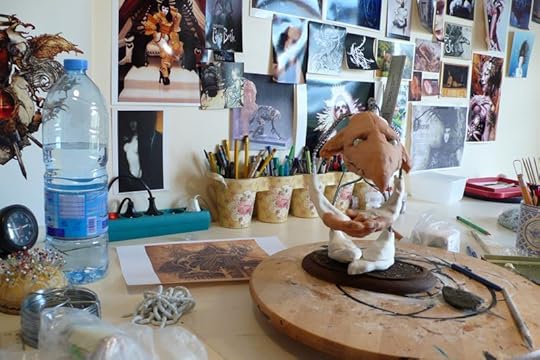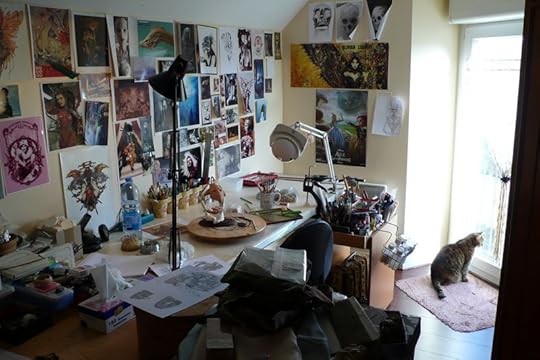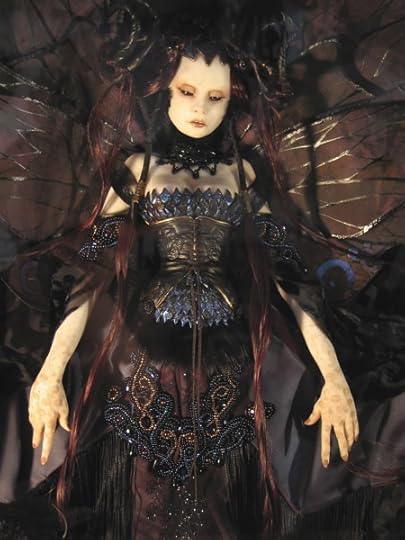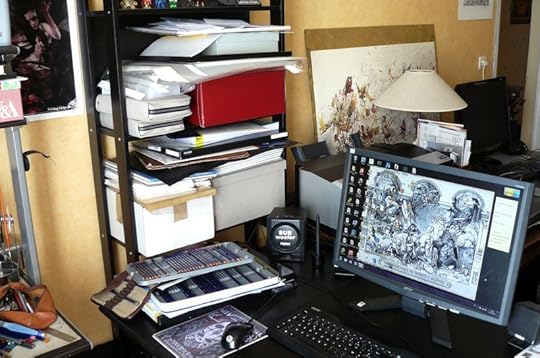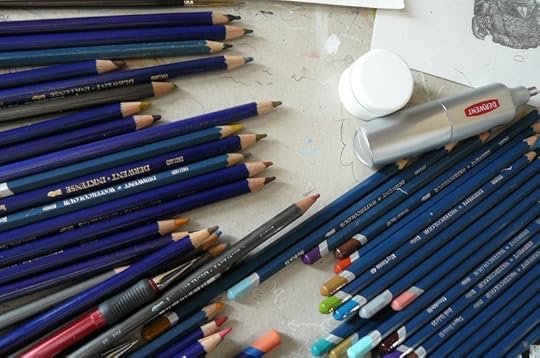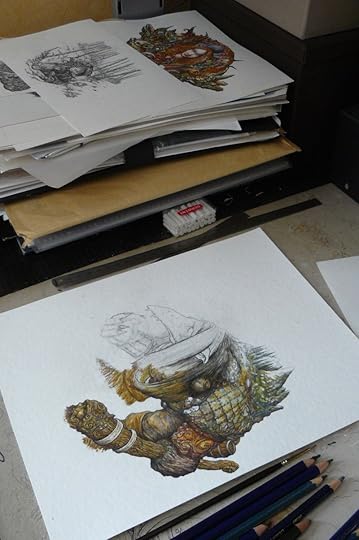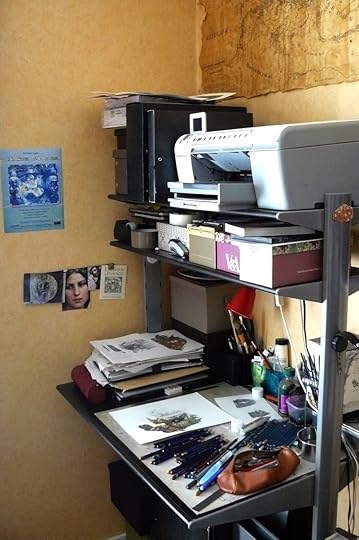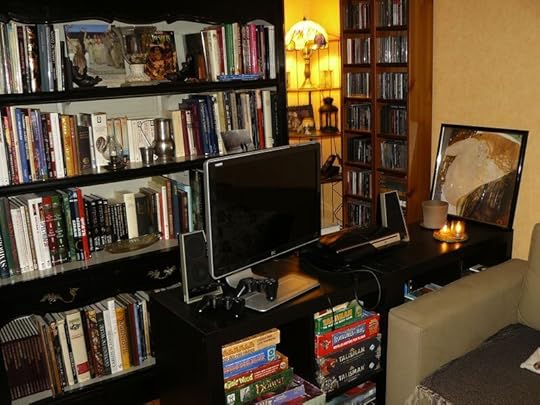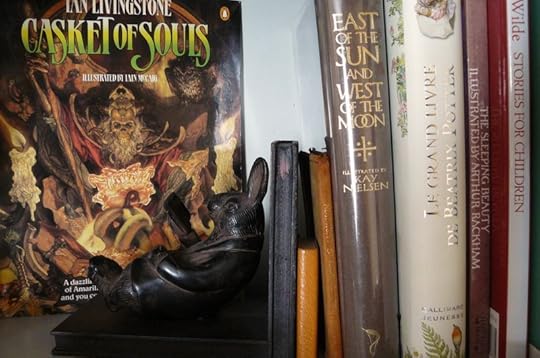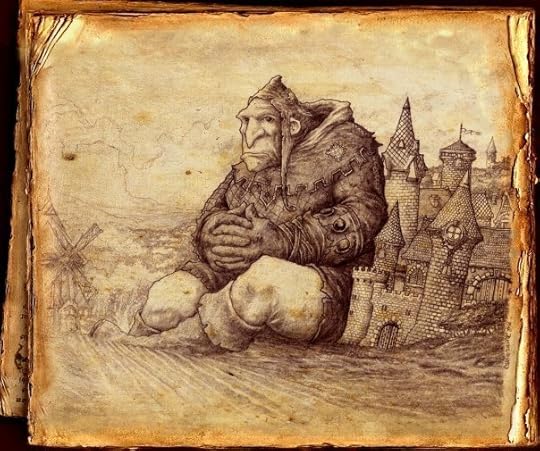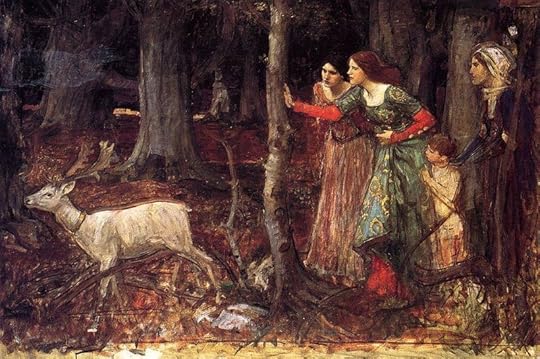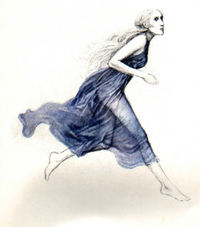Terri Windling's Blog, page 255
February 24, 2011
The Moveable Feast (with today's updates)
The conversation "on blogging as an art form" is spreading: from Rima Staines, Howard Gayton, and Rex Van Ryn on the John Barleycorn blog to:
* "Reflections on Blogging" here at The Drawing Board (Devon, England)
* "The Imagined Village" at Mermaid in the Attic (Perth, Australia)
* "The Moveable Feast in the Forest" at RavenWood Forest (western Massachusetts)
* "On Blogging" by Theodora Goss (Boston, Massachusetts)
* "The Imagined Self" at A Mermaid in the Atti, (Perth, Australia)
* "Magpie Blogging" by Midori Snyder (Tucson, Arizona)
* "To everything its time" by Erzebet YellowBoy Carr (Papaveria Press, England) NEW
* "Around the table with Rima Staines, Part II" at John Barleycorn (Devon, England) NEW
...And if I've missed any other posts related to the Feast that you've written yourself or read somewhere else, please link to them in the Comments. I don't want to miss anyone...
The Moveable Feast (with today's update)
The conversation "on blogging as an art form" is spreading: from Rima Staines, Howard Gayton, and Rex Van Ryn on the John Barleycorn blog to:
* "Reflections on Blogging" here at The Drawing Board (Devon, England)
* "The Imagined Village" at Mermaid in the Attic (Perth, Australia)
* "The Moveable Feast in the Forest" at RavenWood Forest (western Massachusetts)
* "On Blogging" by Theodora Goss (Boston, Massachusetts)
* "The Imagined Self" at A Mermaid in the Atti, (Perth, Australia)
* "Magpie Blogging" by Midori Snyder (Tucson, Arizona)
* "To everything its time" by Erzebet YellowBoy Carr (Papaveria Press, U.K.) NEW
...And if I've missed any other posts related to the Feast that you've written yourself or read somewhere else, please link to them in the Comments. I don't want to miss anyone...
February 23, 2011
Water Stories, 1
A Water Story
On Your Desk
Today's desks come from two friends of mine who are wonderful artists in La Gacilly, which is a beautiful little town in the Brittany region of France, not far from the mythic forest of Broceliande. La Gacilly is as full of artists as our own little village is here on Dartmoor, and thanks to the Two Legends project, there is now a lot of backing-and-forthing between the two places. Long may it continue.
The first desk (above, and in the next four photos below) belongs to doll-maker and multi-media artist Virginie Ropars. Virginie earned a Masters degree in graphic art, then worked in the computer game and animation industries (for TV cartoons) before discovering a needed to make art with her hands, not a computer, and to express her own aesthetic vision. She now creates works that fall in the interstices between sculpture, doll-making, fashion design and illustration, using a variety of materials to reproduce the enchanted characters and worlds that haunt her imagination. Her figures are bright and dark by turn, beautiful and broken, capricious and transcendent. Her art has been exhibited all throughout Europe, Russia, and the United States; profiled in many magazines and journals; and honoured with the Spectrum Silver Award.
"I have this room dedicated to my work," she says; "I also have another spare room with shelves covered with boxes full of fabrics and working stuff."
"I bring all I need for a new creation in my working space and when it is finished I put everything back into boxes. I always need to start a new project with a clean space, which is why sometimes people visiting find my studio 'neat'."
"I can't work without a wall in front of me, as it helps me to focus on the work only, but I cover it with pics of things I like: works from other artists, a bit of my work too, and inspiring things. I sometimes leave books open on the tables all around while I work; it is always good to have beautiful and inspiring things surrounding you."
"My cat keeps me company from time to time between naps. I watch dvds while I sculpt, or listen to music. I don't like working in silence. Despite living in a small town, I can see the woods through the studio window. In spring time and summer I work with the window open, and it is like working outside. I especially love hearing the birds' songs."
One of Virginie's magical art-dolls is below (a dark fairy for all you fairy fans out there), and more of her work can be seen here and here.
Our next desk belongs to David Thiérrée, whose art is also thoroughly bewitching. David is a self-taught artist who has been working as an illustrator since 1989, his commissions ranging from CD covers to book illustrations. He works in a variety of mediums, often combining watercolours, pencils, and computer techniques to achieve his enchanting style of mythic art. He finds inspiration in the work of Alphonse Mucha and the Art Nouveau movement; turn-of-the-century illustrators such as Arthur Rackham, Kay Nielsen, and Edmund Dulac; and comic book artists ranging from Windsor McCay to Charles Vess. His first art book, Mondes Imaginaires, (which many of us are eagerly awaiting), will be published by Spootnik next spring.
"Here's a picture of my ridiculous work place," he says about the photograph above. "I can hardly find enough space for a A4 paper sheet, but, I don't know why, that's the way I draw. In a urge, between two other things to do, while thinking of a lot of things, with not enough room for my own body."
Above: "Pencils, pencils, and more pencils... I need to display nearly all the spectrum when I work, to try anything possible to save my work from mediocrity."
Above: "Work done, work in progress and work to do all gather in a small space. My workspace is tiny, because it's not so important. I learned to draw everywhere, anytime, and my surroundings aren't so important in fact. I can draw in a rolling train, while talking with people, or on the phone, in a bar, at friend's places, during parties, or with my kids running amok around me."
Above: "Computers, printer, and more pencils...."
Above and below: "Another part of the space in which I live and work... Books, books, music, old boardgames, reading rabbit, and more books."
One of David's enchanting drawings is below (I love this big, clumsy fellow), and more can be seen here.
More desks anon.
_____________________________________________________________________________
All readers of this blog are welcome to contribute to the "On Your Desk" series. You'll find more information (and the address where you should send your photo) in the first post of the series.
The Moveable Feast, Updated
The conversation "on blogging as an art form" is spreading: from Rima Staines, Howard Gayton, and Rex Van Ryn on the John Barleycorn blog to:
* "Reflections on Blogging" here at The Drawing Board (Devon, England)
* "The Imagined Village" at Mermaid in the Attic (Perth, Australia)
* "The Moveable Feast in the Forest" at RavenWood Forest (western Massachusetts)
* "On Blogging" by Theodora Goss (Boston, Massachusetts)
* "The Imagined Self" at A Mermaid in the Attic (Perth, Australia)
* "Magpie Blogging" by Midori Snyder (Tucson, Arizona) NEW
...And if I've missed any other posts related to the Feast, please link to them in the Comments.
February 22, 2011
Today's Recommended Reading:
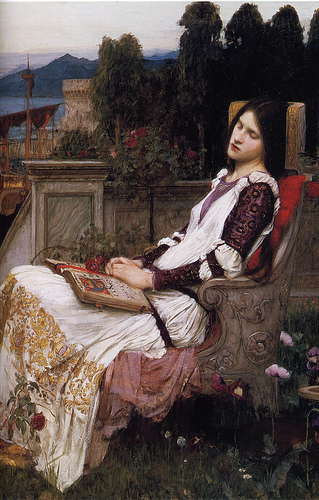 * Jen Percy interviews Anthony Doerr (author of About Grace, The Shell Collector, Memory Wall, etc.) over on the Wags Revue site. Here's a snippit:
* Jen Percy interviews Anthony Doerr (author of About Grace, The Shell Collector, Memory Wall, etc.) over on the Wags Revue site. Here's a snippit:
"Life is wonderful and strange...and it's also absolutely mundane and tiresome. It's hilarious and it's deadening. It's a big, screwed-up morass of beauty and change and fear and all our lives we oscillate between awe and tedium. I think stories are the place to explore that inherent weirdness; that movement from the fantastic to the prosaic that is life....
"What interests me—and interests me totally—is how we as living human beings can balance the brief, warm, intensely complicated fingersnap of our lives against the colossal, indifferent, and desolate scales of the universe. Earth is four-and-a-half billion years old. Rocks in your backyard are moving if you could only stand still enough to watch. You get hernias because, eons ago, you used to be a fish. So how in the world are we supposed to measure our lives—which involve things like opening birthday cards, stepping on our kids' LEGOs, and buying toilet paper at Safeway—against the absolutely incomprehensible vastness of the universe?
"How? We stare into the fire. We turn to friends, bartenders, lovers, priests, drug-dealers, painters, writers. Isn't that why we seek each other out, why people go to churches and temples, why we read books? So that we can find out if life occasionally sets other people trembling, too?"
Indeed.
Today's Reading, Four Recommendations:
 * Jen Percy interviews Anthony Doerr (author of About Grace, The Shell Collector, Memory Wall, etc.) over on the Wags Revue site. Here's a snippit:
* Jen Percy interviews Anthony Doerr (author of About Grace, The Shell Collector, Memory Wall, etc.) over on the Wags Revue site. Here's a snippit:
"Life is wonderful and strange...and it's also absolutely mundane and tiresome. It's hilarious and it's deadening. It's a big, screwed-up morass of beauty and change and fear and all our lives we oscillate between awe and tedium. I think stories are the place to explore that inherent weirdness; that movement from the fantastic to the prosaic that is life....
"What interests me—and interests me totally—is how we as living human beings can balance the brief, warm, intensely complicated fingersnap of our lives against the colossal, indifferent, and desolate scales of the universe. Earth is four-and-a-half billion years old. Rocks in your backyard are moving if you could only stand still enough to watch. You get hernias because, eons ago, you used to be a fish. So how in the world are we supposed to measure our lives—which involve things like opening birthday cards, stepping on our kids' LEGOs, and buying toilet paper at Safeway—against the absolutely incomprehensible vastness of the universe?
"How? We stare into the fire. We turn to friends, bartenders, lovers, priests, drug-dealers, painters, writers. Isn't that why we seek each other out, why people go to churches and temples, why we read books? So that we can find out if life occasionally sets other people trembling, too?"
Indeed.
And more dishes served in The Moveable Feast....
* "The Moveable Feast in the Forest" at RavenWood Forest (in case you missed this link in the Comments yesterday).
* "On Blogging" by Theodora Goss.
* "The Imagined Self" at A Mermaid in the Attic.
(If I've missed any other posts related to Feast, please link to them in the Comments.)
Today's Reading, Two Recommendations:
 1.) Jen Percy interviews Anthony Doerr (author of About Grace, The Shell Collector, Memory Wall, etc.) over on the Wags Revue site. Here's a snippit:
1.) Jen Percy interviews Anthony Doerr (author of About Grace, The Shell Collector, Memory Wall, etc.) over on the Wags Revue site. Here's a snippit:
"Life is wonderful and strange...and it's also absolutely mundane and tiresome. It's hilarious and it's deadening. It's a big, screwed-up morass of beauty and change and fear and all our lives we oscillate between awe and tedium. I think stories are the place to explore that inherent weirdness; that movement from the fantastic to the prosaic that is life....
"What interests me—and interests me totally—is how we as living human beings can balance the brief, warm, intensely complicated fingersnap of our lives against the colossal, indifferent, and desolate scales of the universe. Earth is four-and-a-half billion years old. Rocks in your backyard are moving if you could only stand still enough to watch. You get hernias because, eons ago, you used to be a fish. So how in the world are we supposed to measure our lives—which involve things like opening birthday cards, stepping on our kids' LEGOs, and buying toilet paper at Safeway—against the absolutely incomprehensible vastness of the universe?
"How? We stare into the fire. We turn to friends, bartenders, lovers, priests, drug-dealers, painters, writers. Isn't that why we seek each other out, why people go to churches and temples, why we read books? So that we can find out if life occasionally sets other people trembling, too?"
Indeed.
2.) Theodora Goss joins the Moveable Feast with a post on why she blogs.
On Myth & Writing
This little essay is not new, but I thought I'd post it here today for those who might not have come across it before, as it too deals with issues of creativity and work/life balance.....
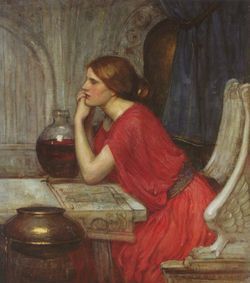 The act of creation, it has always seemed to me, is one of the great magics of our world -- an ancient magic, guarded by the gods, blessed (and coveted) by the fairies. In mythic cosmologies found the world over, specific gods are associated with each of the creative arts: building, weaving, instrument making, theatrical productions, etc., and these gods must be petitioned for their aid, or propitiated against their hindrance. Tribal poets, dancers, musicians, storytellers used their gifts to cross over the boundary lines separating the human realm from the spirit realm and the lands of the living from the lands of the dead; artists performed an almost shamanic function, creating new worlds, new ideas, new realities.
The act of creation, it has always seemed to me, is one of the great magics of our world -- an ancient magic, guarded by the gods, blessed (and coveted) by the fairies. In mythic cosmologies found the world over, specific gods are associated with each of the creative arts: building, weaving, instrument making, theatrical productions, etc., and these gods must be petitioned for their aid, or propitiated against their hindrance. Tribal poets, dancers, musicians, storytellers used their gifts to cross over the boundary lines separating the human realm from the spirit realm and the lands of the living from the lands of the dead; artists performed an almost shamanic function, creating new worlds, new ideas, new realities.
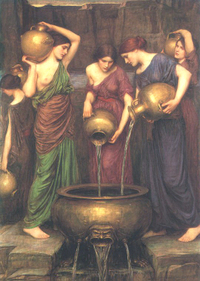 In many ancient cultures, the creative arts were used (both literally and metaphorically) to heal, blight, praise, curse, celebrate, lament, and renew. Inspiration could be sought through one's genius, which was a personal spirit–guide in Greek mythology — or through the Muses, those lovely daughters of Zeus and Mnemosyne (memory): Clio (history), Euterpe (lyric poetry), Thalia (comedy), Melpomene (tragedy), Terpsichore (dance and song), Erato (love songs), Polymnia (divine hymns), Urania (astronomy), and Calliope (epic poetry). In Celtic lands, the Leanan–Sidhe was a faery mistress who inspired poets with her touch — but if misused, her powers could burn too brightly and lead to an early death. The White Deer Woman of Cherokee tales likewise inspired poetry and song, but only to those who show showed her respect as she roamed through the woods in deer form.
In many ancient cultures, the creative arts were used (both literally and metaphorically) to heal, blight, praise, curse, celebrate, lament, and renew. Inspiration could be sought through one's genius, which was a personal spirit–guide in Greek mythology — or through the Muses, those lovely daughters of Zeus and Mnemosyne (memory): Clio (history), Euterpe (lyric poetry), Thalia (comedy), Melpomene (tragedy), Terpsichore (dance and song), Erato (love songs), Polymnia (divine hymns), Urania (astronomy), and Calliope (epic poetry). In Celtic lands, the Leanan–Sidhe was a faery mistress who inspired poets with her touch — but if misused, her powers could burn too brightly and lead to an early death. The White Deer Woman of Cherokee tales likewise inspired poetry and song, but only to those who show showed her respect as she roamed through the woods in deer form.
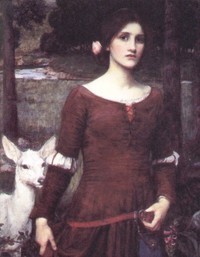 In the field of mythic arts, many of us still seek our inspiration deep in the archetypal forest, following trails blazed through the centuries by the writers and artists who have gone before. We chase the white deer through Shakespeare's fairy plays; through magical poetry by Keats, Goethe, and Yeats; through the visions of the Pre–Raphaelites, the Symbolists, and the Surrealists.
In the field of mythic arts, many of us still seek our inspiration deep in the archetypal forest, following trails blazed through the centuries by the writers and artists who have gone before. We chase the white deer through Shakespeare's fairy plays; through magical poetry by Keats, Goethe, and Yeats; through the visions of the Pre–Raphaelites, the Symbolists, and the Surrealists.
The Muses speak to us not only through stories and dreams, but also through all the creative acts of life: making food, making love, making conversation, making community, making a poem or a prayer out of each moment lived. To some, creative inspiration comes only during life's quiet times; to others, when life is abundantly full — and as artists, we must each learn our own individual ways of summoning the Muses.
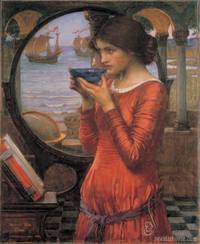 Perhaps, in this non–animist age, few leave out wine and flowers anymore — but we still have our Muse–summoning rituals and talismans: the favorite pen or brand of paper, coffee in a certain mug, paints arranged just so on the palette, the e–mailed box emptied or the phone switched off or the desk surface cleared before we can work . . . all those small rituals we do each time, every time, in order to clear the mind, to focus, to prepare for the crossing from the physical world to the realm of imagination. That moment of crossing is a mythic moment — as potent as the old folk tales where the hero crosses running water (once, twice, three times) to enter Faerieland.
Perhaps, in this non–animist age, few leave out wine and flowers anymore — but we still have our Muse–summoning rituals and talismans: the favorite pen or brand of paper, coffee in a certain mug, paints arranged just so on the palette, the e–mailed box emptied or the phone switched off or the desk surface cleared before we can work . . . all those small rituals we do each time, every time, in order to clear the mind, to focus, to prepare for the crossing from the physical world to the realm of imagination. That moment of crossing is a mythic moment — as potent as the old folk tales where the hero crosses running water (once, twice, three times) to enter Faerieland. 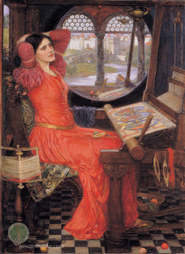 Some days it is easy to make the crossing and to lose ourselves in the creative process; some days it is much harder — and we rarely know which kind of day it will be in advance.
Some days it is easy to make the crossing and to lose ourselves in the creative process; some days it is much harder — and we rarely know which kind of day it will be in advance.
On the most difficult days, one can't cross at all — as if Janus, god of the threshold, or Hermes, god of boundaries, stands firmly blocking the way. Occasionally I've recognized this "writer's block" as a necessary thing: a time to let the dry well of inspiration fill up with water once more. At other times, it feels like a banishment, and I fear that the gates might stay locked up too long. "When I don't write," lamented Anais Nin (in 1966, at the height of her success), "I feel my world shrinking. I feel I am in prison. I feel I lose my fire and color. Writing is a necessity, as the sea needs to heave, and I call it breathing."
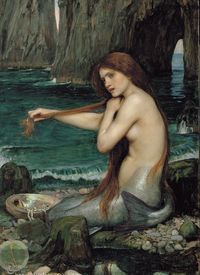 Sometimes it's not a lack of inspiration but a lack of time that interferes with one's ability to create. In May Sarton's splendid novel Mrs. Stevens Hears the Mermaids Singing, a poet's struggle with her Muse, and with the tools of her trade, are often overshadowed by a deeper, less romantic struggle: the effort to push life aside long enough to actually get to her desk. Thomas Mann echoed this sentiment in his Autobiography of a Novelist. We can't wait for those perfect moments, he warns us, when daily life seems to melt away and nothing exists but the fire of inspiration. Those moments of grace are precious, but rare. Treasure them, he says, but don't depend upon them; for the rest of the time we must be able to work despite the bills clamoring for attention, the dog barking, the telephone ringing, and the mailman at the door.
Sometimes it's not a lack of inspiration but a lack of time that interferes with one's ability to create. In May Sarton's splendid novel Mrs. Stevens Hears the Mermaids Singing, a poet's struggle with her Muse, and with the tools of her trade, are often overshadowed by a deeper, less romantic struggle: the effort to push life aside long enough to actually get to her desk. Thomas Mann echoed this sentiment in his Autobiography of a Novelist. We can't wait for those perfect moments, he warns us, when daily life seems to melt away and nothing exists but the fire of inspiration. Those moments of grace are precious, but rare. Treasure them, he says, but don't depend upon them; for the rest of the time we must be able to work despite the bills clamoring for attention, the dog barking, the telephone ringing, and the mailman at the door.
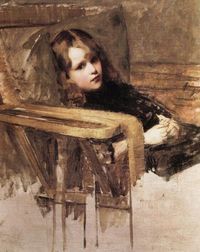 In her inspiring collection The Gates of Excellence, writer Katherine Anne Paterson has what is, for me, the last word on the subject of the artist's perpetual struggle to find a balance of time for both life and art: "I had no study in [the early] days, not even a desk or file or bookcase to call mine alone . . . .It might have happened sooner [the writing of work worthy of publication] had I had a room of my own and fewer children, but somehow I doubt it. For as I look back on what I have written, I can see that the very persons who took away my time and space are those who have given me something to say."
In her inspiring collection The Gates of Excellence, writer Katherine Anne Paterson has what is, for me, the last word on the subject of the artist's perpetual struggle to find a balance of time for both life and art: "I had no study in [the early] days, not even a desk or file or bookcase to call mine alone . . . .It might have happened sooner [the writing of work worthy of publication] had I had a room of my own and fewer children, but somehow I doubt it. For as I look back on what I have written, I can see that the very persons who took away my time and space are those who have given me something to say."
As for me, it's the siren call of nature and the richness of life itself that keep luring me away from my writing desk...but which, conversely, provide me with tales to tell when I find my way back. Then, like all writers, I'm faced with that frightening and holy object: the blank white page. But it only takes one sentence, one word, to begin. . .and then, gods willing, the Muses come.
And I'm away with the fairies....
___________________________________________________________________________
The art in this is post is by John William Waterhouse (1849-1917), a painter in the "second wave" of the Pre-Raphaelite movement...except for the little fairy at the end, which is by Alan Lee.
Terri Windling's Blog
- Terri Windling's profile
- 712 followers


